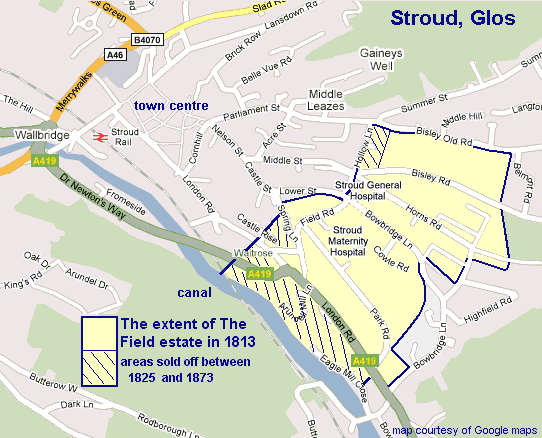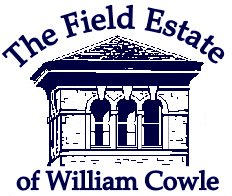
Between 2010 and 2014, Marion Hearfield and Tony Macer researched the building development of the hillside in Stroud where they live. Marion had started the year before, intrigued by a set of names in the title deeds of her house (her essays about the CALLAND and HAWKINS families are here). In 2010 Tony wanted to know who had built his house, further down the hill: all he knew was that there was a date and pair of initials over the front door, but he did have his title deeds.
They started asking around their neighbours, and the research project grew. They were encouraged by the then Collections Officer at the Museum in the Park, who said the planned archive would be so detailed and comprehensive that it would be an invaluable resource for future researchers of Victorian social history. Highlights of the research as it progressed are offered on the FEWC home page.
At the end of 2013, when all the excitement of the book launch and exhibition had subsided, Marion settled down to assemble the digital archive. By the end of April 2014 it was complete and copies were donated to various local organisations in May.
The research material

There are over 2,200 files (research notes, title deed pages, maps and ephemera) stored in 166 folders, occupying 2.5Gb. The file structure looks like this:
- \READ ME - a folder with Introduction, copyright conditions and so on, and a master plan of the hillside showing every lot and every house. The folder also contains a PDF of an illustrated talk given by Marion to the Stroud Local History Society in February 2014 - a quick tour and overview that explains the how and what of the project.
- \000 is the folder and subfolders about William Cowle himself, his family, his wife's family, his early property projects (including Exchange Buildings); the preliminary work to get The Field estate suburb bought, laid out, serviced, and ready to sell; the auction itself, and the early buyers.
- \001 to \103 - these are the Lot-based folders, one for each of the 103 building Lots sold by William in 1873. Each folder contains everything we have discovered about the development of that particular lot. It also contains House Histories and title deeds, where they are available, and any ephemeral note that has surfaced.
- \1000 series - a set of folders with information about the houses that were built on the earlier Arundell estate before William bought the land (the four-digit code is the piece number used in the 1841 Tithe Apportionment of the town).
- \2000 - More than 1,200 people appear in the Lot Notes and House Histories that summarise the information in the title deeds lent to the researchers (which is why the searchable database is so useful). But some of them require their own research note so this folder contains cameos of those key people. There is also a list of all the builders, with a contemporary essay about building a house in the 1890s. (Click here to see a plain list of names.)
- \3000 - this folder contains maps and panorama views of the hillside.
- \4000 - this folder contains Marion's annotated transcripts (Excel spreadsheets) of the censuses taken on roads on or near The Field estate (from 1841 to 1911). The people here are not indexed in the database - there are far too many - but the transcripts are searchable.
A freely available copy of our digital archive is offered via cloud storage online at 2014 FEWC ARCHIVE for personal and academic research, subject to the Creative Commons copyright licence described in the archive's READ ME folder. The cloud storage also contains the searchable database.
The searchable database
The searchable database that accompanies the archive was written for us by Liz Wright. This allows users to browse through all the records or search for a person or a house, and see/print a list of all the research documents in which that person/house is mentioned in the archive. Users first need to download the .EXE that puts a runtime version of Access on their computer, then the database itself can be opened locally (making a database that can be run on any application, under any operating system, was above our pay grade; we decided that a standalone runtime version was the simplest way round such pitfalls). In case all else fails, the archive READ ME folder offers a spreadsheet of the 1,200+ people mentioned in the Lot Notes and House Histories and the different parts they played, and a list of the houses, but without the useful overlay of browsing offered in the database.
A quick check: 1,270 people are named in the archive; almost all of them are from Stroud. Some appear only once; others appear quite a few times. Their roles are very different - they could be vendors, purchasers, tenants, lenders, borrowers, trustees, or executors. In the COWLE and BIRT family data files they could be siblings, cousins, aunts, great-nieces and nephews. Where it is obvious that the same person is playing different roles their data is collected into one Person record in the database. Where it is obvious there were two (or more) people with the same name they are labelled (1 of 2), (2 of 2) and so on. But occasionally the title deeds only give a surname and we could get no closer. If you would find it helpful to have a quick look at all the names, please click here. The list shows every name and the date they first make their entrance in the archive (though for obvious privacy reasons, the more recent (post-1960s) vendors and purchasers are not identified in the database though they do appear in the individual House Histories). If any of the names attracts your interest then please consult the full FEWC archive.
Where to find the archive
Copies of the research archive, on DVD, have been deposited at the Gloucestershire Archives and the Stroud Museum. Copies have also been donated to the Stroud Local History Society and Stroud Library and other local organisations, for their own use.
For researchers who cannot visit the County Archives, a freely available copy is also available online at 2014 FEWC ARCHIVE. This link takes you to the FEWC archive stored on the internet in pCloud. The archive itself is very large but it is not necessary to download it to be able to browse through - you can see the first page of each file on the server, choose the documents you want for your own research, and save just those. All of this data is freely available under a Creative Commons licence, as described in the READ ME folder already mentioned.
The long-term maintenance of the archive is still to be decided. In the short term, any corrections or additions will be made and uploaded to the archive on the Copy cloud server. Marion and Tony are both well past retirement age so in the long term - who can say?


